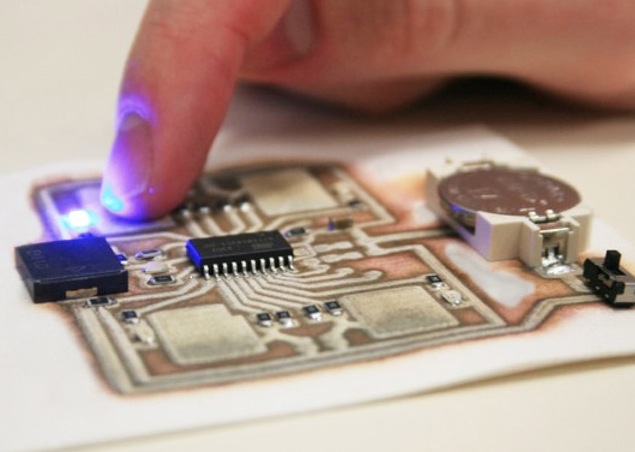3D printing manufacturers have begun to hyper-drive their products to market and startups are jumping on the bandwagon. Already, 3D-printed prosthetics, toys, games, art, lawnmowers, tools, and more, are hitting the marketplace. While this is evidence that 3D printing will become increasingly visible in the electronics arena soon, there are several challenges facing the PCB industry, in particular, that are absent in more general-purpose segments. For example, the design of PCBs can be very complex, given their materials, shrinking size, and specification requirements. When the obstacles are overcome, 3D printing promises to make the process of PCB creation faster, better, and more efficient. Here’s a look at where we are, what’s on the drawing board, and some of the challenges yet to be solved.
The Concept Isn’t Necessarily New
Fortunately, the foundation for the concept of 3D printing is not anything new. Similar processes have been in place for years whereby UV lasers cured liquid photopolymers and created solid objects. Layers were added from the bottom up until the tops of the objects were completed, mirroring the 3D printing processes of today.
Also dubbed additive manufacturing, 3D printing uses heat, material deposition, inkjet layering, and lasers, to ultimately build objects. The 3D printing processes of today are rapidly gaining momentum, ready to shake up manufacturing flexibility and speed, enable new and different products, eliminate a substantial amount of manufacturing waste, enable global production of complex parts, and dramatically reduce the need for huge spare-part inventories. For home use, 3-D printers use thermoplastic extrusion, in which heated plastic thread is used and is squeezed into the creation of the desired object.
In a recent research report, MarketsandMarkets estimates that 3D printing across all market segments will be worth $8.43 billion by 2020. 3D printing has spread across many segments, from hobbyists to serious designers.
In the electronics industry, manufacturers at the cutting-edge of 3D printing processes and developments include NanoDimension, Stratasys, and 3D Systems. NanoDimension, for example, is focused on 3D printing of multi-layer PCBs for professional-grade printed electronics use. The company also manufactures its own proprietary inks.
Assessing the Challenges
The 3D printing of electronics has many challenges that must be addressed before the technology becomes the norm. These challenges are centered primarily on materials, as well as the process development to achieve sufficient conductivity and resolution for professional yields.
Printing conductive traces for print electronics, while improving, is still underwhelming industry-resolution requirements. Novel silver nanoparticle inks exist, but they require curing by heat, chemicals, or light to form a conductive silver trace. While fully functional parts are successfully created from such materials as plastics, alloys, and ceramics, the application size varies as does the respective materials used. From printing on fabric for wearables to the printing of PCBs on paper, the number of considerations for materials and processes is seemingly endless.
Building multi-layer PCBs requires high-quality and predictable materials and equipment. Trace conductivity is only part of the solution; three-axis capabilities and insulating structural inks add to the complexity. Given many possible materials, precision requirements and a vast number of potential applications … well, the challenges become apparently very quickly.
Standards will become important in this space. Emerging standards such as IEEE 1149.7 compact JTAG and IEEE P1687 internal JTAG can be used together to embed test structures in 3D ICs. And the IEEE 1500 standard for embedded-core test may find use in accessing individual dies in a 3D stack.
 The Cartesian EX1 3D PCB printer enables printing on paper. (Source: Stuff Magazine)
The Cartesian EX1 3D PCB printer enables printing on paper. (Source: Stuff Magazine)
There are many situations that are evolving concurrently along with 3D printing. As boards become smaller and applications demand ever-higher performance and data rates as well as low voltage, there’s a greater emphasis on signal quality and power delivery.
And, it’s a moving target. For example, once inks deliver sufficiently conductive traces with high resolution for 3D printing, board materials will move up in importance. FR-4 represents the current bar in rigid boards, but flexible boards are gaining traction within the industry with unique design-dependent requirements. Finally, to add even more confusion, software that ties it all together will need to effectively translate 2D Gerber files into 3D printing instructions.
A recent Kickstarter project was launched to fund the Functionalize F-Electric, a 3D printing filament the creators claim is 1,000 times more electrically conductive than anything on the market. The filament allows 3D printing of circuit wires, sensors, power connectors and electrical components inside projects printed from 3D PLA-capable printers. The company is using nanomaterials and processes, which they expect will be the basis of a variety of functional materials needed for designs and prototypes.
As designers go through the process of evaluating electrical performance, and mastering the variety of PCBs coming into play in the 3D printing realm, improved decision and engineering skills will be necessary. On one hand, 3D printing will alleviate time and resource pressures; on the other, there is still additional complexity falling squarely on the shoulders of designers.
Into the Future
There’s no doubt that 3D printing will deliver dramatically faster development and that it will become sufficiently reliable and advanced for precision prototyping and small runs – in time. Lining up strategic partnerships with reliable manufacturing and assembly partners is key in the meantime. As Advanced Assembly continues to work with designers through design, prototype, and small runs today, the company stands ready to implement 3D printing when the time is right and technology advancements are sufficiently in place.
By: Carolyn Mathas
Advertisement
Learn more about Advanced Assembly





